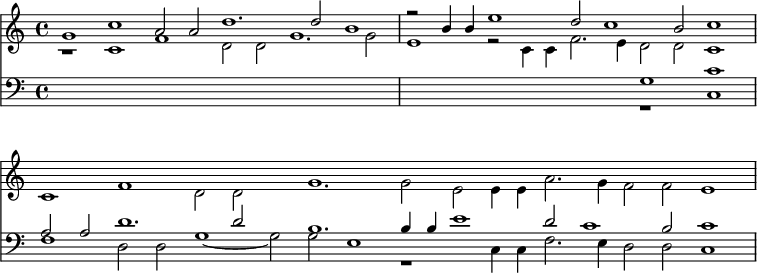When a note which is sharpened in the signature becomes altered in the course of the composition to a flat, or vice versa, the alteration is sometimes expressed by the sign ♮♭ or ♮♯, the object of the natural being to cancel the signature, while the following flat or sharp indicates the further alteration, as in Schubert's 'Impromptu,' Op. 90, No. 2, bars 4 and 164; this is, however, not usual, nor is it necessary, as a single sharp or flat fully answers the purpose. (See Beethoven, Trio, op. 97, bar 35).
Until about the beginning of the 17th century the accidentals occurring during a composition were often not marked, the singers or players being supposed to be sufficiently educated to supply them for themselves. In the signature only the first flat, B♭, was ever marked, and indeed we find numerous examples of a similar irregularity as late as Bach and Handel, who sometimes wrote in G minor with one flat, in C minor with two, and so on. Thus Handel's Suite in E containing the 'Harmonious Blacksmith' was originally written with three sharps, and is so published in Arnold's edition of Handel's works, No. 128; and the trio in 'Acis and Galatea,' 'The flocks shall leave the mountains,' though in C minor, is written with two flats in the signature and the third marked throughout as an accidental. In the same way the sharp seventh in minor compositions, although an essential note of the scale, is not placed in the signature, but is written as an accidental.
In French the chromatic alterations are expressed by the words dièse (sharp) and bémol (flat) affixed to the syllables by which the notes are usually called; for example, E♭ is called mi-bémol, G♯ sol-dièse, etc. and in Italian the equivalents diesis and bemolle are similarly employed, but in German the raising of a note is expressed by the syllable is and the lowering by en joined to the letter which represents the note, thus G♯ is called Gis, G♭ Ges, and so on with all except B♭ and B♮, which have their own distinctive names of B and H. Some writers have lately used the syllable Hes for B♭ for the sake of uniformity, an amendment which appears to possess some advantages, though it would be more reasonable to restore to the present H its original name of B, and to employ the syllables Bis and Bes for B sharp and B flat. [App. p.517 "See also Cis, Dis, Hexachords, and Notation."]
[ F. T. ]
ACCOMPANIMENT. This term is applied to any subsidiary part or parts, whether vocal or instrumental, that are added to a melody, or to a musical composition in a greater number of parts, with a view to the enrichment of its general effect; and also, in the case of vocal compositions, to support and sustain the voices.
An accompaniment may be either 'Ad libitum' or 'Obligato.' It is said to be Ad libitum when, although capable of increasing the relief and variety, it is yet not essential to the complete rendering of the music. It is said to be Obligato when, on the contrary, it forms an integral part of the composition.
Among the earliest specimens of instrumental accompaniment that have descended to us, may be mentioned the organ parts to some of the services and anthems by English composers of the middle of the 16th century. These consist for the most part of a condensation of the voice parts into two staves; forming what would now be termed a 'short score.' These therefore are Ad libitum accompaniments. The following are the opening bars of 'Rejoyce in the Lorde allwayes,' by John Bedford (about 1543):—

Before speaking of Obligato accompaniment it is necessary to notice the remarkable instrumental versions of some of the early church services and anthems, as those by Tallis, Gibbons, Amner, etc. which are still to be met with in some of the old organ and other MS. music books. These versions are so full of runs, trills, beats, and matters of that kind, and are so opposed in feeling to the quiet solidity and sober dignity of the vocal parts, that even if written by the same hand, which is scarcely credible, it is impossible that the former can ever have been designed to be used as an accompaniment to the latter. For example, the instrumental passage corresponding with the vocal setting of the words 'Thine honourable, true, and only Son,' in the Te Deum of Tallis (died 1585) stands thus in the old copies in question:—
![{ \override Score.TimeSignature #'stencil = ##f \time 16/8 << { \set Staff.midiInstrument = #"church organ" \set Score.tempoHideNote = ##t \tempo 4 = 120 \clef treble << \relative g' { g2 c ~ c8[ b c a] b[ a b gis] | a[ gis a fis] gis[ fis gis e] c'[ b c a] b[ a b gis] } \\ \relative e' { e2 e1 e2 | e e e e } >> | a'2. a'4 gis'1 | }
\new Staff { \set Staff.midiInstrument = #"church organ" \clef bass << \relative b { b2 a1 gis2 | c8[ b c a] b[ a b gis] a[ gis a fis] gis[ fis gis e] } \\ \relative e { e2 a,1 e'2 | c e a, e' } >> | \relative c { c8[ b c gis] a[ e c a] e'1^\markup { \raise #2 \smaller etc. } } } >> }](http://upload.wikimedia.org/score/p/a/pakyloplhgdtd28xpz5wy2ysh6uc15w/pakylopl.png)
while that of the phrase to the words 'The noble army of martyrs praise Thee,' in the well-

